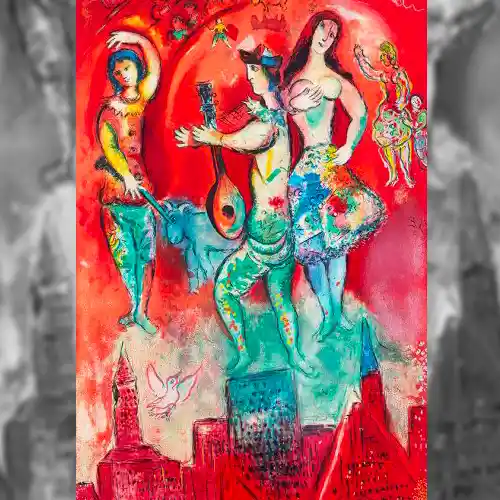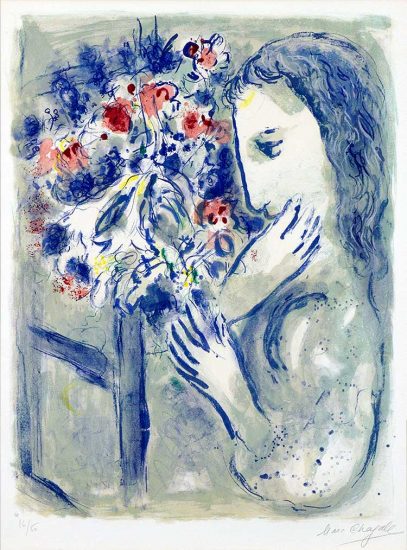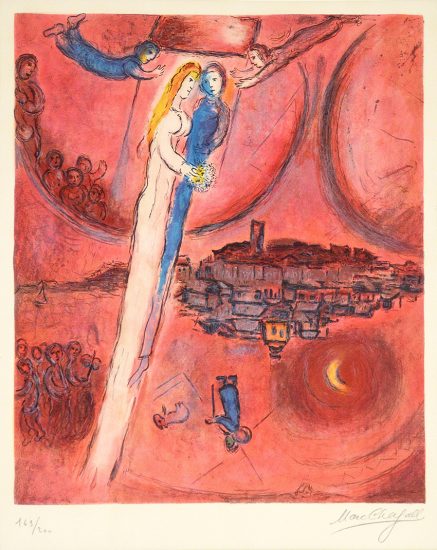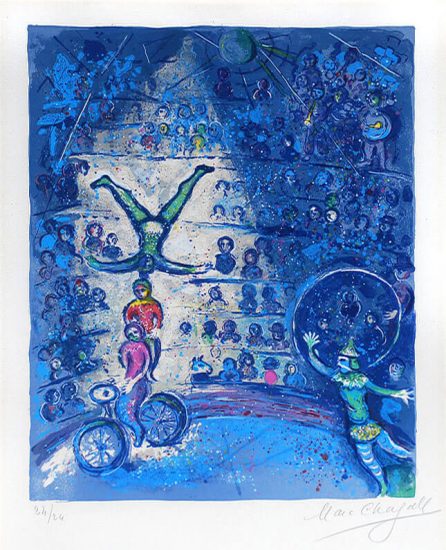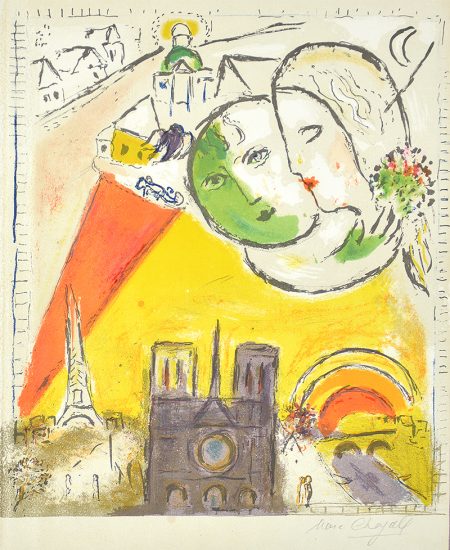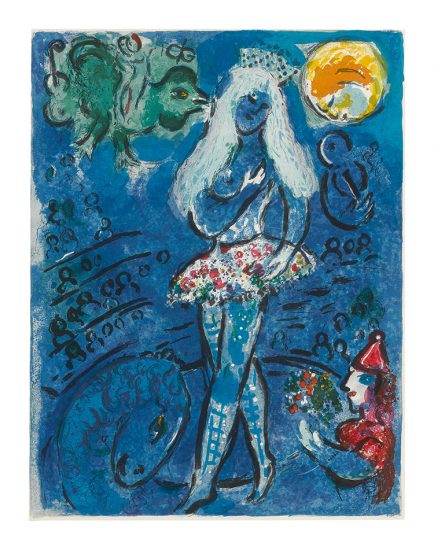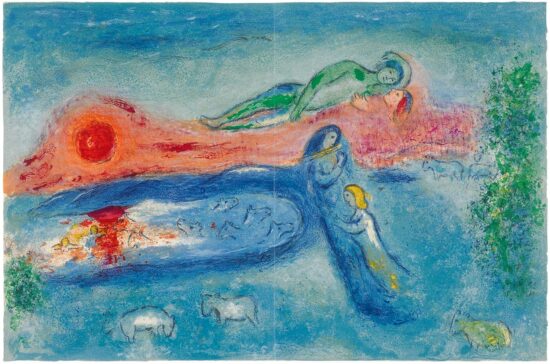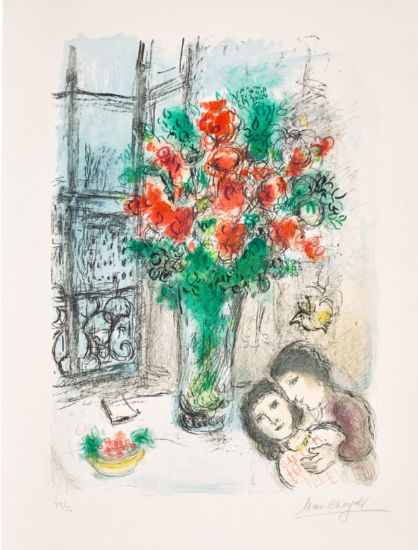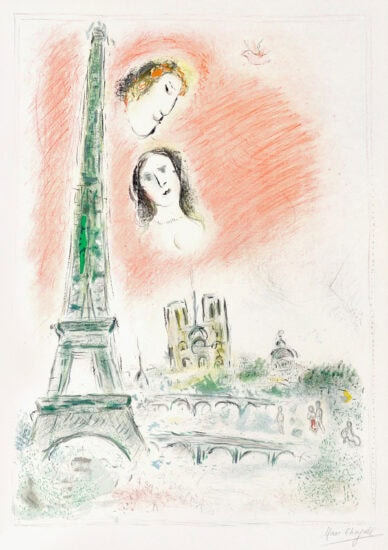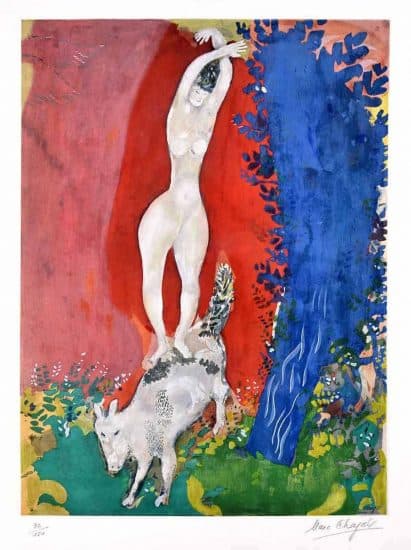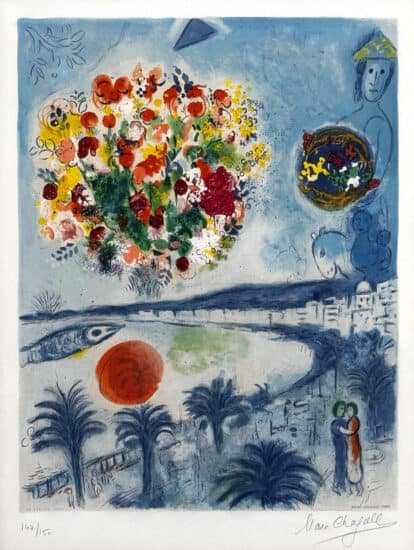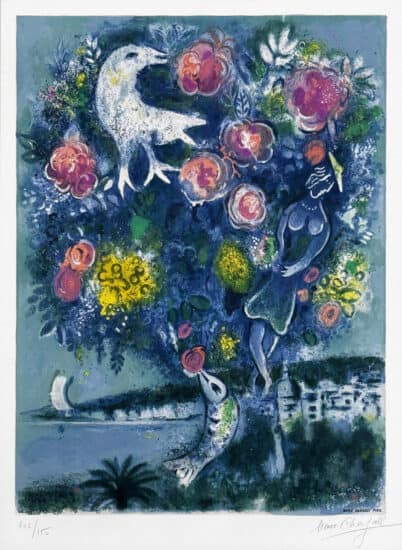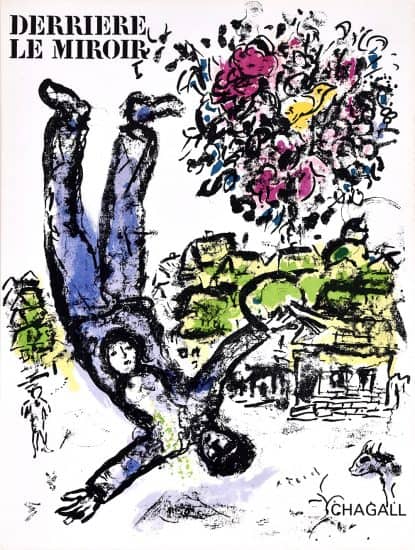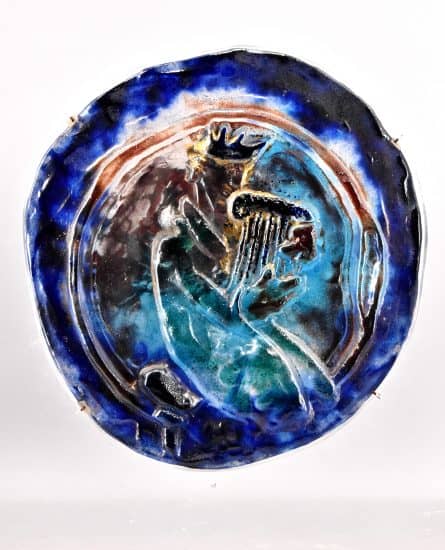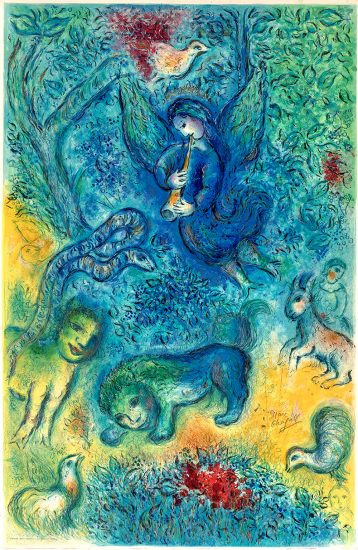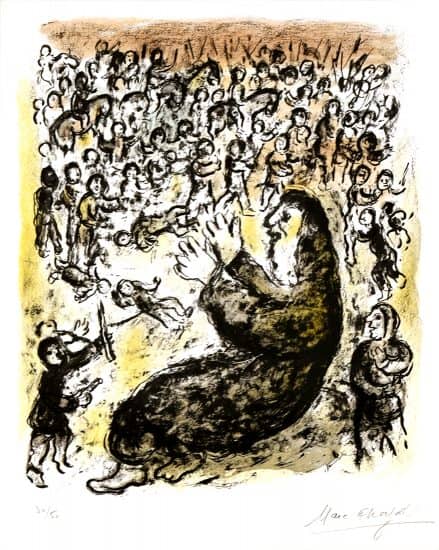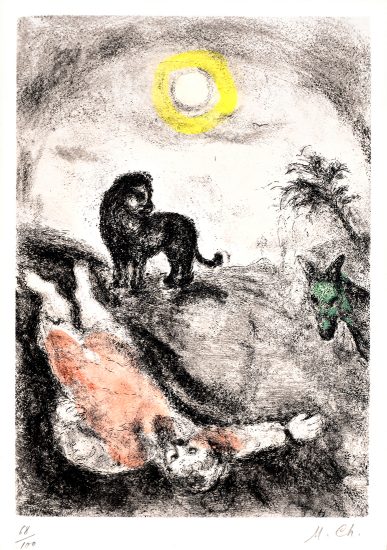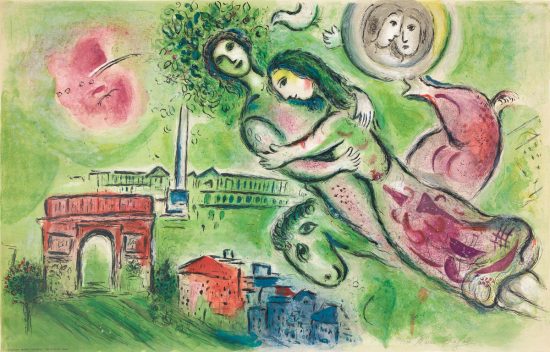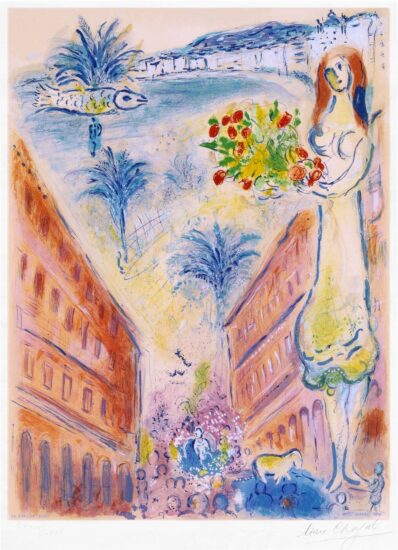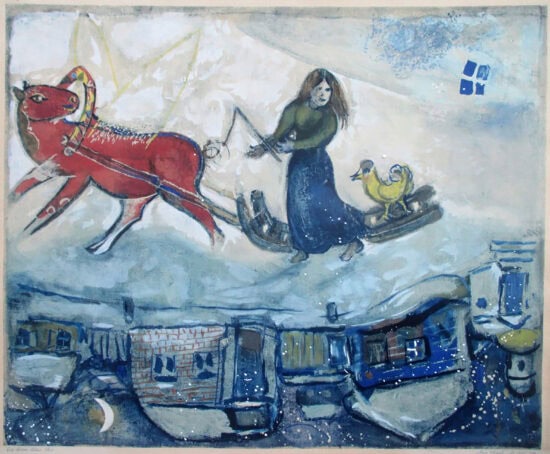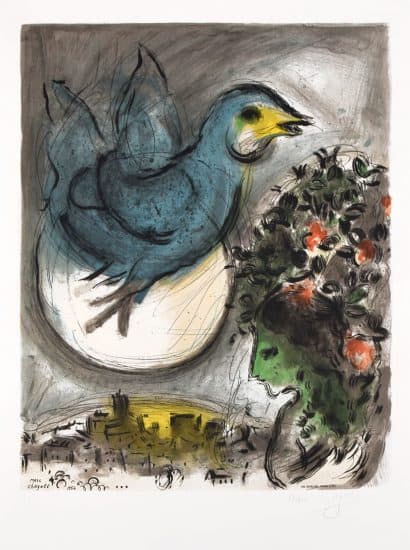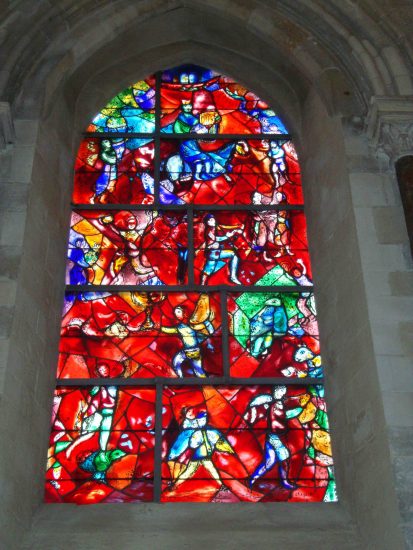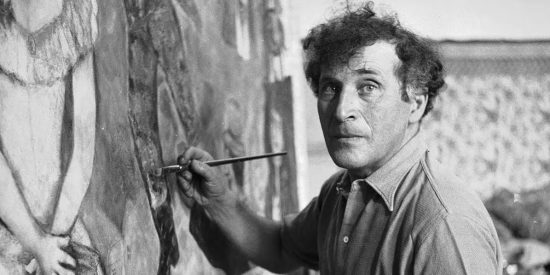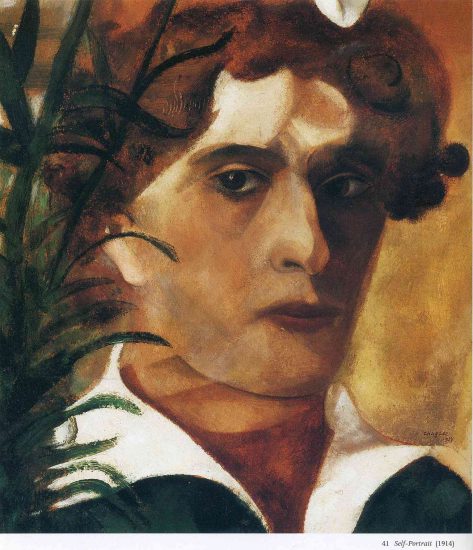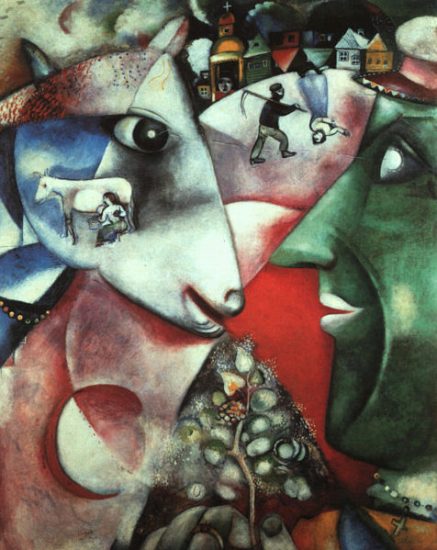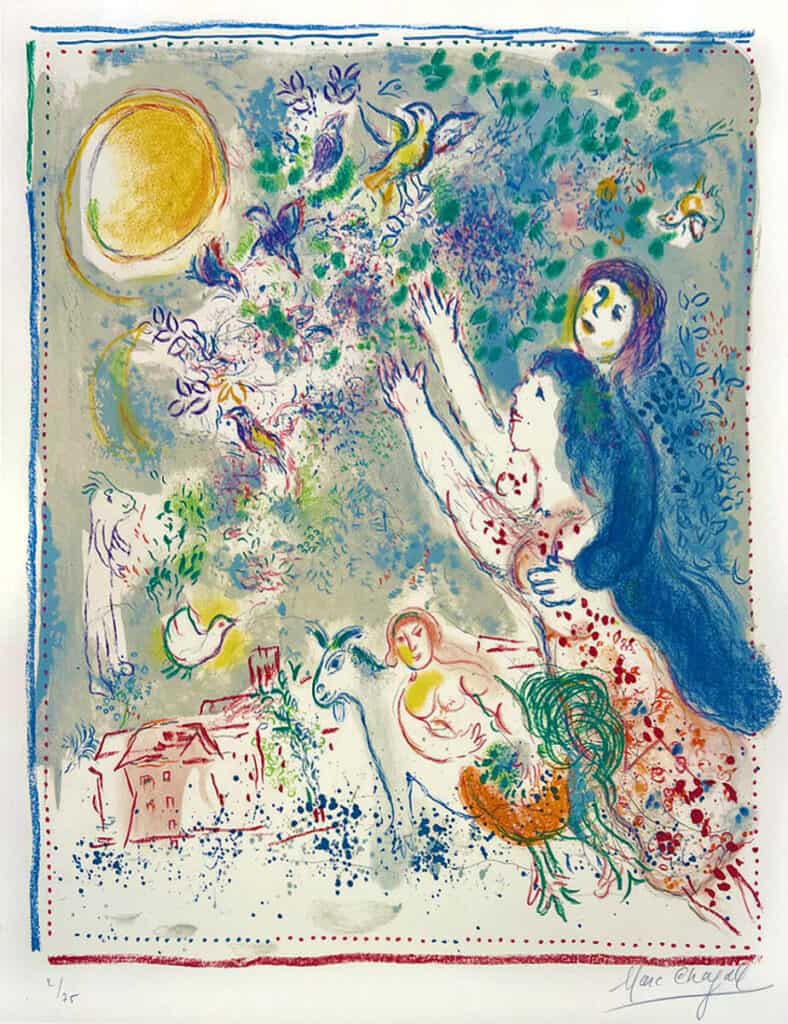
Key Highlights
- Marc Chagall was a prolific artist who produced over 1,000 lithographs and over 500 etchings throughout his career.
- His lithographs are known for their vibrant colors and whims imagery, making them highly sought after by collectors.
- Chagall's lithographs are a significant part of his oeuvre, showcasing his contributions to modern art and his innovative techniques.
- Collectors should look for key features of genuine Chagall lithographs, such as original color, wove paper, and the use of lithographic stone.
- Chagall lithographs can be found in public and private collections, and their value can vary based on factors such as rarity and condition.
- Proper care and display of Chagall lithographs are essential to preserve their quality and value.
Introduction
Marc Chagall was a renowned artist known for his vibrant and imaginative artworks. While he is primarily recognized for his paintings, Chagall also made significant contributions to the art of lithography. Throughout his career, he produced a vast number of lithographs, showcasing his unique artistic style and mastery of the medium.
Chagall's lithographs are characterized by their vivid colors, dreamlike imagery, and whimsical motifs. They capture the essence of his paintings, bringing to life his imaginative world filled with floating figures, flying violins, and colorful landscapes. Chagall's lithographs, including those created for his famous "Jerusalem Windows" series, are highly sought after by collectors and art enthusiasts for their beauty and artistic significance.
In this blog, we will explore the key highlights of Marc Chagall's lithographs, understand their significance in his oeuvre, and learn how to identify authentic Chagall lithographs. We will also delve into the process of collecting Chagall lithographs, including where to find them and the factors that affect their value. Additionally, we will provide tips on caring for and preserving Chagall lithographs, as well as highlight some of his notable works and their stories. Whether you are a seasoned collector or simply appreciate Chagall's art, this guide will provide valuable insights into the world of Marc Chagall lithographs.
Understanding Marc Chagall's Artistic Journey
Marc Chagall's artistic journey is an intriguing tale of creativity, resilience, and cultural exploration. Born in 1887 in Vitebsk, Belarus (then part of the Russian Empire), Chagall discovered his passion for art at an early age. He studied art in Saint Petersburg and later moved to Paris in 1910, where he encountered the avant-garde art movements of the time. (Read our artistic biography of Marc Chagall)
Chagall's time in Paris was a period of artistic growth and experimentation. He embraced the vibrant art scene and was influenced by artists such as Pablo Picasso and Henri Matisse. Chagall's unique style emerged, combining elements of Cubism, Fauvism, and Symbolism with his own imaginative and dreamlike imagery.
However, Chagall's journey took a tumultuous turn with the outbreak of the First World War. Unable to return to Paris, he settled in his hometown of Vitebsk, where he became involved in the Russian Revolution and served as Commissar for Art. Despite the political and ideological challenges, Chagall continued to create art, infusing his works with a sense of nostalgia for his homeland and Jewish heritage.
In 1922, Chagall left Russia and moved to Berlin, where he began his foray into printmaking on the advice of a local publisher. This marked the beginning of his exploration of lithography, a medium that would become an essential part of his artistic repertoire. Chagall's lithographs captured the essence of his paintings, with their vibrant colors and whimsical imagery. His artistic journey continued through the tumultuous years of the Second World War, and his prints of this time reflect the emotional and cultural impact of the war on his work.
Chagall's artistic journey continued to evolve, with significant periods spent in France, the United States, and other parts of the world. His works reflect his experiences, emotions, and cultural influences, making him one of the most celebrated artists of the 20th century.
Early Life and Inspirations
Marc Chagall's early life in Russia played a significant role in shaping his artistic style and inspirations. Born in a small town in present-day Belarus, Chagall grew up in a vibrant Jewish community that deeply influenced his art. The Judaean hills and the rich folklore of his hometown served as recurring motifs in his works, including his famous stained glass windows for the Hadassah-Hebrew University Medical Center Synagogue in Israel, representing the Twelve Tribes of Israel.
Chagall's childhood memories of his family, religious rituals, and his observations of daily life in the Jewish community provided him with a rich source of inspiration. His works often depict scenes of village life, Jewish traditions, and biblical stories, blending reality with dreamlike elements.
The colors and landscapes of Russia also left a lasting impact on Chagall's artistic vision. The vibrant palette and imaginative use of color in his works can be traced back to the vivid memories of his homeland.
Throughout his career, Chagall continued to draw inspiration from his roots, infusing his artistic expression with a sense of nostalgia and spirituality. His works reflect a unique blend of personal experiences and universal themes, making them resonate with audiences around the world.
Transition into Lithography
Marc Chagall's transition into lithography marked a significant turning point in his artistic career. It was in the early 1950s, after returning to France from his time in the United States, that Chagall began his friendship and collaboration with the printer Marc Chagall Lithographs and Signed Original Prints
Charles Sorlier at Atelier Mourlot.
Atelier Mourlot was a renowned lithography studio in Paris, frequented by artists such as Picasso, Braque, and Miró. Chagall's collaboration with Sorlier allowed him to explore the possibilities of the lithographic medium and push its boundaries.
Working at Atelier Mourlot, Chagall experimented with various techniques and innovations in lithography. He worked closely with master printer Georges Sagourin, who became one of his favorite collaborators. Their collaboration resulted in the creation of vibrant and imaginative lithographs that captured the essence of Chagall's paintings.
Chagall's transition into lithography during this period was greatly influenced by his collaboration with Atelier Mourlot and master printer Fernand Mourlot, as well as his assistant Georges Sagourin and the eminent art dealer Ambroise Vollard. His lithographs from this period showcase his mastery of the medium, with their vibrant colors, fluid lines, and whimsical imagery. This collaboration, led by master printer Jacques Lassaigne, became an integral part of Chagall's artistic repertoire, allowing him to further explore his artistic vision and reach a wider audience.
The Significance of Lithographs in Chagall's Oeuvre
Lithographs hold a significant place in Marc Chagall's oeuvre, showcasing his artistic evolution and contributions to the world of printmaking. Chagall embraced lithography as a medium that allowed him to translate the vibrant colors and whimsical imagery of his paintings into prints. His lithographs, or chagall prints, capture the essence of his unique style, with their dreamlike landscapes, floating figures, and imaginative motifs. Chagall's lithographs, or chagall lithographe, including the iconic Marc Chagall self portrait, showcase his mastery of the medium, highlighting his innovative techniques and his ability to create visually compelling and emotionally resonant artworks. Collecting Chagall lithographs, or chagall lithographe, allows art enthusiasts to own a piece of his artistic legacy and appreciate the depth and beauty of his imaginative world.
Chagall’s Contribution to Modern Art through Lithography
Marc Chagall's contribution to modern art extends beyond his paintings and encompasses his innovative work in lithography. His lithographs played a pivotal role in shaping the modern art movement and capturing the spirit of the time.
Chagall's lithographs showcase his unique artistic style, characterized by vibrant colors, dreamlike imagery, and whimsical motifs. They reflect the influence of various art movements such as Fauvism, Cubism, and Symbolism, while also embodying Chagall's personal artistic vision.
One notable example of Chagall's contribution to modern art through lithography is his collaboration with the Paris Opera. In 1964, Chagall was commissioned to design the sets and costumes for a production of Ravel's ballet "Daphnis et Chloé." His lithographs for the ballet showcased his innovative use of color and his ability to create visually stunning and emotionally evocative artworks.
Chagall's lithographs continue to inspire and influence artists and art enthusiasts alike, leaving a lasting impact on the world of modern art.
Techniques and Innovations in Chagall’s Lithographs
Marc Chagall's lithographs are not only known for their vibrant colors and whimsical imagery but also for the techniques and innovations he employed in their creation.
One of the key techniques used by Chagall in his lithographs was the incorporation of original color. Unlike traditional lithographs that relied on separate plates for each color, Chagall introduced a method where multiple colors were applied to a single stone or plate. This technique allowed him to achieve a rich and varied color palette, adding depth and dimension to his lithographs.
Chagall also paid careful attention to the choice of paper for his lithographs. He often used wove paper, which has a smooth texture and allows for fine details and vibrant colors to be captured effectively.
These techniques and innovations in Chagall's lithographs showcase his technical mastery and his ability to push the boundaries of the medium. They contribute to the overall beauty and artistic appeal of his lithographs, making them highly sought after by collectors and art enthusiasts.
Identifying Authentic Marc Chagall Lithographs
Identifying authentic Marc Chagall lithographs is essential for collectors to ensure that they are acquiring genuine artworks. With the popularity of Chagall's lithographs, it is crucial to be aware of key features that distinguish an authentic Chagall lithograph from a reproduction or forgery.
One of the primary indicators of authenticity is the use of original color in the lithograph. Chagall often used a technique where multiple colors were applied to a single stone or plate, resulting in a rich and varied color palette. The presence of vibrant and well-defined colors is a strong indication of an authentic Chagall lithograph.
Another important aspect to consider is the choice of paper. Chagall often used wove paper, which has a smooth texture and allows for fine details and vibrant colors to be captured effectively. The use of high-quality paper can contribute to the overall value and authenticity of the lithograph.
Additionally, it is essential to authenticate a Chagall lithograph through provenance and documentation. Collectors should look for certificates of authenticity, gallery stamps, or other documentation that verifies the artwork's origin and authenticity.
By paying attention to these key features and conducting thorough research, collectors can ensure that they are acquiring genuine Marc Chagall lithographs that hold both artistic and monetary value.
Key Features of Genuine Chagall Lithographs
Genuine Marc Chagall lithographs possess several key features that distinguish them from reproductions or forgeries. These features are crucial for collectors to identify and authenticate Chagall lithographs.
One key feature of genuine Chagall lithographs is the use of original color lithographs. Chagall often employed a technique where multiple colors were applied to a single stone or plate, resulting in vibrant and well-defined colors. The presence of a rich and varied color palette is a strong indication of an authentic Chagall lithograph.
Another important feature to consider is the choice of paper. Chagall frequently used wove paper, which has a smooth texture and allows for fine details and vibrant colors to be captured effectively. The use of high-quality paper contributes to the overall value and authenticity of the lithograph.
Additionally, collectors should look for signatures or editions numbers on the lithograph. Chagall often signed his lithographs, and editions were typically numbered to indicate their limited availability.
By paying attention to these key features and consulting experts or reputable sources, collectors can confidently identify genuine Marc Chagall lithographs and add them to their collections.
Tips for Verifying Authenticity
Verifying the authenticity of a Marc Chagall lithograph requires careful examination and consideration of various factors. Here are some tips to help collectors in this process:
- Consult experts or reputable sources to authenticate the lithograph based on the key features mentioned above.
- Look for signatures or edition numbers on the lithograph, as Chagall often signed and numbered his lithographs.
- Research the provenance of the lithograph, including its history of ownership and documentation.
- Examine the lithograph for characteristics specific to Chagall's techniques, such as the use of original color and the choice of paper.
- Consider the collaboration between Chagall and Atelier Mourlot, as the studio played a significant role in producing his lithographs.
By following these tips and conducting thorough research, collectors can verify the authenticity of a Marc Chagall lithograph and make informed decisions when adding to their collections.
Collecting Marc Chagall Lithographs
Collecting Marc Chagall lithographs can be a rewarding experience for art enthusiasts and collectors. Chagall's lithographs are highly sought after for their vibrant colors, whimsical imagery, and artistic significance. Here are a few things to consider when collecting Chagall lithographs:
- Research and educate yourself about Chagall's lithographs, including their key features, styles, and periods.
- Set a budget and determine the types of lithographs or specific works you are interested in collecting.
- Explore reputable galleries, art dealers, and auction houses that specialize in Chagall lithographs.
- Consider the condition and provenance of the lithograph, as well as any accompanying documentation or certificates of authenticity.
- Connect with other collectors or join art communities to expand your knowledge and network.
Collecting Chagall lithographs allows art enthusiasts to appreciate the beauty and artistic legacy of one of the most celebrated artists of the 20th century.
Where to Find Chagall Lithographs
Chagall lithographs can be found in various art markets and venues, providing collectors with opportunities to acquire these coveted artworks. Here are some places to look for Chagall lithographs:
- Reputable galleries specializing in modern and contemporary art often have Chagall lithographs available for sale.
- Art fairs and exhibitions dedicated to Chagall's works may showcase lithographs from private collections or art dealers.
- Online platforms and auction houses, such as Christie's and Sotheby's, regularly feature Chagall lithographs in their sales.
- Local art events, art shows, and art societies may occasionally have Chagall lithographs for sale or display.
- Connecting with other collectors or joining art communities can provide valuable insights and leads on where to find Chagall lithographs.
Collectors should exercise due diligence when purchasing Chagall lithographs, ensuring the authenticity and condition of the artworks before making a purchase.
Factors Affecting the Value of Chagall Lithographs
Several factors can influence the value of Marc Chagall lithographs, making them highly sought after by collectors. Here are some key factors to consider:
- Rarity: The scarcity of a particular Chagall lithograph can significantly impact its value. Limited editions or lithographs from important series are often more valuable due to their limited availability.
- Condition: The condition of the lithograph, including its preservation and any signs of damage or restoration, can affect its value. Lithographs in excellent condition are more desirable to collectors.
- Provenance: The history of ownership and the documentation supporting the lithograph's authenticity and provenance can impact its value. Lithographs with well-documented provenance often hold higher value.
- Art Market: The trends and demand in the art market can influence the value of Chagall lithographs. Factors such as exhibitions, retrospective shows, and market demand can impact prices.
- Subject and Theme: The subject matter and theme of the lithograph can also play a role in its value. Chagall's iconic motifs, such as lovers, biblical stories, and whimsical landscapes, are often in high demand.
By considering these factors, collectors can gain a better understanding of the value of Chagall lithographs and make informed decisions when buying or selling.
| Column Name A | Column Name B |
| Rarity | Limited editions or lithographs from important series |
| Condition | Excellent preservation and absence of damage or restoration |
| Provenance | Well-documented history of ownership and authenticity |
| Art Market | Trends, demand, and exhibitions in the art market |
| Subject and Theme | Iconic motifs, biblical stories, and whimsical landscapes |
Caring for Your Marc Chagall Lithographs
Proper care and handling of Marc Chagall lithographs are essential to preserve their quality and value over time. Here are some tips for caring for your Chagall lithographs:
- Handling: When handling lithographs, make sure to clean and dry your hands thoroughly to avoid transferring oils or dirt onto the paper. Use acid-free gloves or handle the lithograph along the edges to prevent smudging or damage.
- Framing: Proper framing is crucial for protecting lithographs from light, dust, and humidity. Use acid-free and archival-quality materials for matting, backing, and framing. UV-resistant glass or acrylic can also be used to protect the lithograph from fading due to exposure to sunlight.
- Display: Avoid displaying lithographs in direct sunlight or areas with high humidity. Choose a location away from heat sources, such as radiators or fireplaces, as extreme temperatures can damage the paper and colors.
- Cleaning: If necessary, consult a professional conservator for cleaning and preservation. Avoid using water or cleaning solutions on the lithograph as they can cause damage. Dusting with a soft, dry, and lint-free cloth is usually sufficient for regular maintenance.
By following these care guidelines, you can ensure the longevity and preservation of your Marc Chagall lithographs, allowing you to enjoy their beauty and value for years to come.
Preserving the Quality of Lithographs
Preserving the quality of Marc Chagall lithographs requires proper handling, framing, and storage techniques. Here are some essential tips for preserving the quality of your lithographs:
- Handle with care: When handling lithographs, use clean, dry hands and avoid touching the printed areas. Hold the lithograph by its edges or use acid-free gloves to prevent oils and dirt from damaging the paper or colors.
- Frame with archival materials: Use acid-free mats, mountings, and backing boards when framing lithographs. UV-resistant glass or acrylic should be used to protect against fading and damage from sunlight.
- Avoid direct sunlight: Display lithographs in areas away from direct sunlight or harsh artificial light. Prolonged exposure to light can cause fading and discoloration.
- Maintain stable humidity and temperature: Avoid extreme fluctuations in humidity and temperature, as this can damage the lithograph. Avoid displaying lithographs in areas prone to moisture, such as bathrooms or kitchens.
- Store in acid-free materials: If not displayed, store lithographs in acid-free folders or boxes made from archival-quality materials. This will protect them from dust, light, and environmental damage.
By following these preservation techniques, you can ensure that your Marc Chagall lithographs retain their quality and value for generations to come.
Displaying Your Chagall Lithographs
Displaying your Marc Chagall lithographs can enhance your enjoyment of these beautiful artworks while also preserving their quality. Here are some tips for displaying your Chagall lithographs:
- Choose a suitable location: Select a space with good lighting and minimal exposure to direct sunlight. Avoid areas with high humidity, such as bathrooms or kitchens.
- Use proper framing: Have your lithographs professionally framed using archival-quality materials. Acid-free mats and UV-resistant glass or acrylic should be used to protect the lithograph from fading and damage.
- Consider grouping or theme-based displays: Create a cohesive display by grouping lithographs with similar themes or motifs. This can enhance the visual impact and storytelling aspect of the artworks.
- Rotate displays: To prevent prolonged exposure to light and minimize potential damage, consider rotating your lithographs periodically. This allows you to enjoy different pieces while preserving the quality of the artworks.
- Seek professional advice: If you are unsure about the best way to display your Chagall lithographs, consult with a professional art advisor or framer who specializes in preserving and displaying works on paper.
By following these tips, you can showcase your Marc Chagall lithographs in a way that enhances their beauty and preserves their value over time.
Highlighted Works and Their Stories
Marc Chagall created numerous iconic lithographs throughout his career, each with its own unique story and significance. Here are two highlighted works and their stories:
- "The Blue Circus": This lithograph captures the whimsical and dreamlike atmosphere of a circus. Chagall's use of vibrant blue hues and floating figures evokes a sense of magic and enchantment. The lithograph portrays acrobats, animals, and musicians, showcasing Chagall's fascination with the circus as a metaphor for the human experience.
- "I and the Village": This lithograph is one of Chagall's most famous works, depicting a dreamlike village scene. It features floating figures, a goat, and a high-contrast composition that blends reality and fantasy. The lithograph is inspired by Chagall's childhood memories of his hometown and showcases his unique artistic style and narrative storytelling.
Both of these lithographs exemplify Chagall's ability to convey emotion, nostalgia, and imagination through his art. They continue to captivate viewers and are highly sought after by collectors for their artistic significance and visual appeal.
The Story Behind “The Blue Circus”
"The Blue Circus" is a color lithograph created by Marc Chagall. It depicts a whimsical circus scene, capturing the enchantment and magic of the circus with its vibrant blue hues and floating figures.
Chagall was fascinated by the circus and often used it as a metaphor for the human experience in his artworks. "The Blue Circus" showcases acrobats, animals, and musicians, evoking a sense of wonder and joy.
The lithograph reflects Chagall's unique artistic style, combining elements of fantasy, folklore, and dreamlike imagery. It portrays the circus as a place where reality and imagination intertwine, inviting viewers into a world of enchantment.
"The Blue Circus" is a testament to Chagall's ability to convey emotion and storytelling through his art. It continues to captivate audiences and is highly valued by collectors for its artistic significance and visual appeal.
Exploring “I and the Village”
"I and the Village" is a renowned color lithograph created by Marc Chagall. It is one of his most iconic works, featuring a dreamlike village scene that blends reality and fantasy.
The lithograph depicts floating figures, a goat, and a high-contrast composition, showcasing Chagall's unique artistic style and narrative storytelling. It is inspired by his childhood memories of his hometown and reflects his fascination with the imagery and symbolism of village life.
"I and the Village" is a visual representation of Chagall's imagination and his connection to his Jewish roots. It exemplifies his ability to create art that is both deeply personal and universally resonant.
The lithograph's vibrant colors, dreamlike imagery, and narrative qualities have made it a beloved and highly sought-after artwork. It continues to captivate viewers and is considered a masterpiece of modern art.
Marc Chagall Lithographs in Modern Collections
Marc Chagall lithographs hold a prominent place in modern art collections around the world. Their vibrant colors, whimsical imagery, and artistic significance have made them highly sought after by collectors.
Chagall lithographs can be found in both public and private collections. Public collections, such as museums and galleries, often showcase Chagall's lithographs as part of their permanent or temporary exhibitions. These institutions recognize the importance and impact of Chagall's lithographs on the art world and the wider cultural landscape.
Private collections also feature Chagall lithographs, with collectors acquiring these artworks for their beauty, artistic value, and potential investment. Chagall lithographs have been sold at renowned auction houses, such as Christie's and Sotheby's, with prices reaching significant figures.
The value of Chagall lithographs in modern collections can vary based on factors such as rarity, condition, and provenance. Highly sought-after lithographs from important series or with unique features can command significant prices in the art market.
Whether displayed in public or private collections, Chagall lithographs continue to captivate audiences and leave a lasting impact on the world of modern art.
Public and Private Collections Featuring Chagall
Marc Chagall's lithographs can be found in numerous public and private collections around the world. These collections showcase the beauty, significance, and artistic legacy of Chagall's work.
Public collections, such as museums and galleries, often feature Chagall lithographs as part of their permanent or temporary exhibitions. Institutions like the Museum of Modern Art (MoMA) in New York, the Musée National Marc Chagall in Nice, and the Tate Modern in London have notable collections of Chagall's lithographs.
Private collections also house significant Chagall lithographs. These collections are often amassed by passionate collectors and art enthusiasts who appreciate the unique artistic vision and emotional resonance of Chagall's works.
While public collections offer the opportunity for a wider audience to experience Chagall's lithographs, private collections provide collectors with the pleasure of owning and living with these beautiful artworks.
Overall, both public and private collections contribute to the preservation of Chagall's artistic legacy and ensure that future generations can appreciate the beauty and significance of his lithographs.
Recent Auction Records and Trends
In recent years, the auction market for Marc Chagall lithographs has seen remarkable records and trends. The demand for his prints has remained consistently high, with collectors and art enthusiasts vying for these valuable pieces.
One notable auction record was set for Chagall's lithograph "Nicolai Gogol: Les Ames Mortes," which sold for £21,420 in June 2022 at Christie's Online. This complete set of 96 etchings, published in 1948, showcases Chagall's expressive use of etched lines and aquatint tones.
Another significant auction record was achieved for Chagall's lithograph "Jean de La Fontaine: Fables," which sold for £18,900 at the same auction. This complete set of 102 etchings with aquatint, published in 1952, exemplifies Chagall's mastery of the medium.
These auction records demonstrate the enduring appeal and value of Chagall's lithographs in the art market. Collectors continue to recognize the quality and significance of his prints, making them an excellent investment choice.
Conclusion
Marc Chagall's lithographs are not just art pieces; they are windows into his soul and artistic evolution. Understanding his journey from inspirations to innovations in lithography is key to appreciating the significance of these works. Authenticity plays a vital role in collecting Chagall's lithographs, so knowing how to identify genuine pieces and caring for them is essential. Whether you seek to start your collection or already own Chagall lithographs, preserving their value and history is paramount. Dive into the world of Chagall's lithographs, explore their stories, and immerse yourself in the beauty of these timeless pieces that continue to captivate art enthusiasts worldwide.
Frequently Asked Questions
How Do I Know if My Chagall Lithograph is Original?
If you own a Chagall lithograph and want to determine its originality, several factors can help. Firstly, look for vibrant and authentic colors that Chagall himself intended for the print. Secondly, check for the involvement of Atelier Mourlot, a renowned lithography studio where Chagall frequently worked. The studio's collaboration with Chagall adds authenticity and value to the lithographs.
Are Marc Chagall Lithographs a Good Investment?
Marc Chagall lithographs have proven to be excellent investments in the art market. With their vibrant colors, whimsical imagery, and high demand among collectors, Chagall's prints have achieved significant auction records. Collectors recognize the value and artistic merit of these lithographs, making them a compelling investment choice.

